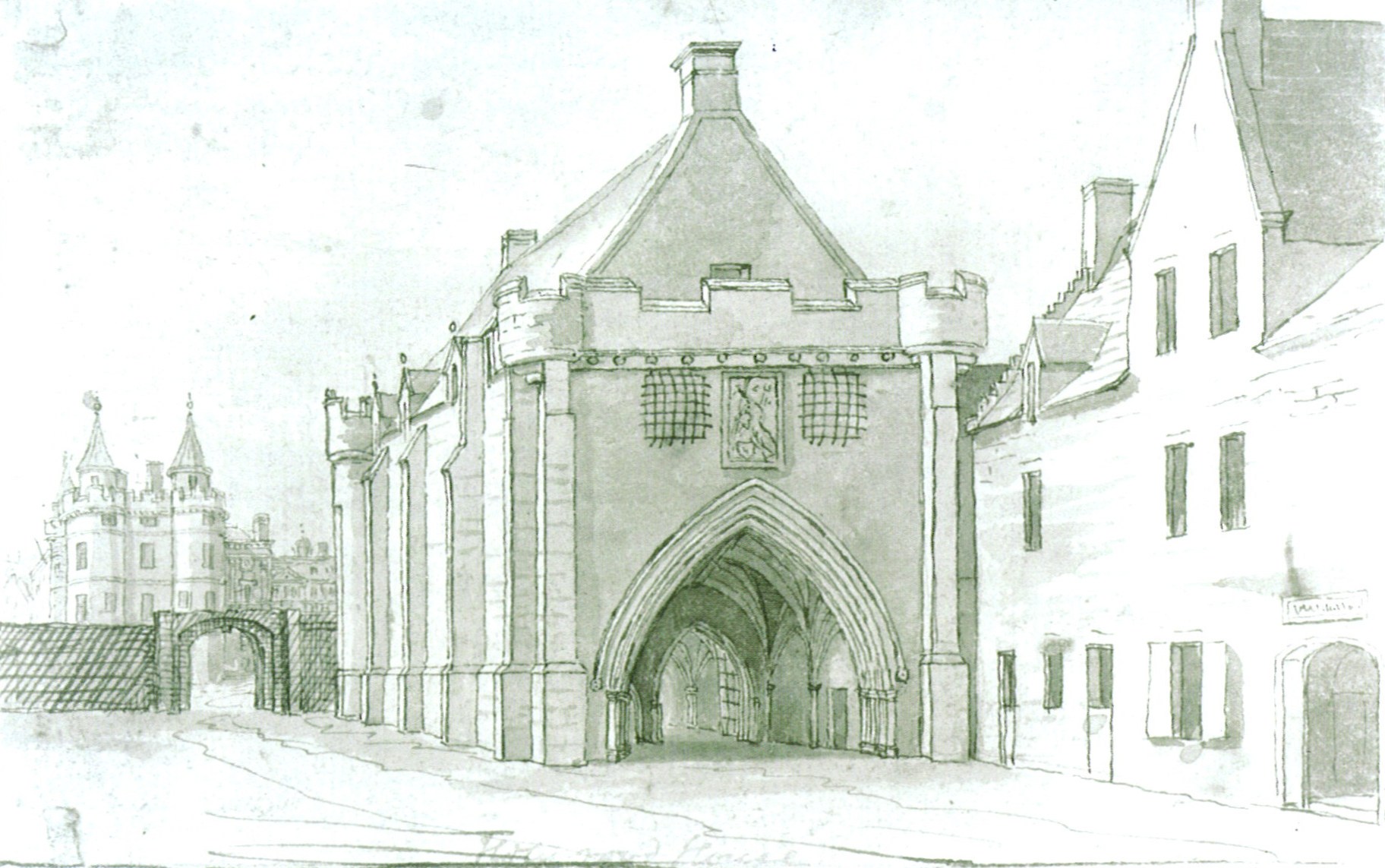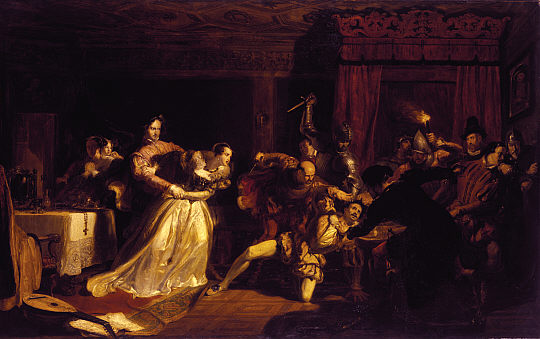|
Edward Bruce, 1st Lord Kinloss
Edward Bruce, 1st Lord Kinloss Privy Council of the United Kingdom, PC (1548 – 14 January 1611) was a Scottish lawyer and judge. He was the second son of Edward Bruce of Blairhall and Alison Reid. Career In 1594 James VI of Scotland, James VI sent him as ambassador to London and gave him £1,000 Pounds Scots, Scots for his expenses. With James Colville, 1st Lord Colville of Culross, James Colville, he was sent to invite Elizabeth I of England, Queen Elizabeth to send a representative to the masque at the baptism of Prince Henry, baptism of Prince Henry, discuss the matter of the Francis Stewart, 5th Earl of Bothwell, Earl of Bothwell, Catholics in Scotland, and ask for the English subsidy of James VI, yearly sum of money that Elizabeth gave to James VI. They were to ensure the money was paid to Thomas Foulis. He also requested the rendition of Anne of Denmark, Anne of Denmark's goldsmith Jacob Kroger who had fled to England with the queen's jewels. Bruce was sent to London ... [...More Info...] [...Related Items...] OR: [Wikipedia] [Google] [Baidu] |
Julian Goodare
Julian Goodare is a professor of history at University of Edinburgh. Academic career Goodare studied at the University of Edinburgh in the 1980s, afterwards engaged as a postdoctoral fellow. He lectured at the University of Wales, and at the University of Sheffield. He returned to work at Edinburgh in 1998. He was the co-director of the Survey of Scottish Witchcraft alongside Louise Yeoman. In 2019, he called for a memorial to Scotland's tortured and executed witches. Goodare has published articles and book chapters on crown finance in the early modern period. Subjects include the administration known as the Octavians, and the annual sums of money which Elizabeth I gave James VI of Scotland, which he argues ought to be known as the English subsidy. He explored the significance of the " Ainslie Bond", made in support of the Earl of Bothwell, in the light of Jenny Wormald Jennifer Wormald (18 January 1942 – 9 December 2015) was a Scottish historian who studied late medieva ... [...More Info...] [...Related Items...] OR: [Wikipedia] [Google] [Baidu] |
Barony Of Muirton
Baron of Muirton is a title of nobility in the Baronage of Scotland. The first known Crown charter was granted in 1532, to Robert Reid (bishop), Robert Reid, Abbot of Kinloss. In 2019, the current baron ascended to the title The M. Hon. Dr. Richard Bruce Culbert of Muirton, 32nd Baron of Muirton. Baronies originated during the Middle Ages and were lands held by barons in feu as "tenants in chief" of the monarch. The baron had the rights to the production of the land and was responsible to maintain law and order in the name of the king. He usually had to provide military forces in times of war, as well. Over time law enforcement and other powers were gradually stripped from barons. In Scotland, the Abolition of Feudal Tenure etc. (Scotland) Act 2000, Abolition of Feudal Tenures Act 2000 separated the title of baron from the land becoming a personal title and allowed it to be transferred as an incorporeal hereditament. Location The boundaries of the Barony have changed ove ... [...More Info...] [...Related Items...] OR: [Wikipedia] [Google] [Baidu] |
Kinloss Abbey
Kinloss Abbey is a Cistercian abbey at Kinloss in the county of Moray, Scotland. The abbey was founded in 1150 by King David I "in order to extend the benefits of civilisation to the remoter regions under his sway." The legend of its founding is similar to that of the founding of Holyrood Abbey. According to the legend, while hunting, the king lost his way in the woods but was rescued by a deer, which guided him to a clearing. He was later persuaded by a vision, which he regarded to have been sent by the Virgin Mary, to build a church there in her honor. It was first colonised by monks from Melrose Abbey. It received its Papal Bull from Pope Alexander III in 1174, and later came under the protection of the Bishop of Moray in 1187. The abbey went on to become one of the largest and wealthiest religious houses in Scotland, receiving the valuable salmon fishing rights on the River Findhorn from Robert the Bruce in 1312, subsequently renewed by James I and James IV. During ... [...More Info...] [...Related Items...] OR: [Wikipedia] [Google] [Baidu] |
Valentine Thomas
Valentine Thomas (died 1603) was an English servant or soldier whose confession in 1598 as a would-be assassin of Elizabeth I caused tension between England and Scotland. Thomas's confession implicated James VI of Scotland, who wrote several letters to Elizabeth to ensure his rights to English throne were unharmed. Arrest and confession Valentine Thomas was arrested in March 1598 at Morpeth. A Scottish man captured in England, Robert Crawforth, gave testimony that prompted Thomas's arrest. He described meeting Thomas and the usher or door keeper John Stewart at Holyrood Palace in 1597. John Stewart gave Thomas access to the palace and James VI. James had another servant of that name, John Stewart of Rosland, usually identified as a valet. Crawforth, who was transferred to the Marshalsea prison in London, described one aspect of a conspiracy, that Valentine Thomas had offered to engage the support of English Catholics to put James on the English throne. Crawforth was encouraged to ... [...More Info...] [...Related Items...] OR: [Wikipedia] [Google] [Baidu] |
Holyrood Palace
The Palace of Holyroodhouse ( or ), commonly known as Holyrood Palace, is the official residence of the British monarch in Scotland. Located at the bottom of the Royal Mile in Edinburgh, at the opposite end to Edinburgh Castle, Holyrood has served as the principal royal residence in Scotland since the 16th century, and is a setting for state occasions and official entertaining. The palace adjoins Holyrood Abbey, and the gardens are set within Holyrood Park. The King's Gallery, Edinburgh, King's Gallery was converted from existing buildings at the western entrance to the palace and was opened in 2002 to exhibit works of art from the Royal Collection. Charles III, King Charles III spends one week in residence at Holyrood at the beginning of summer, where he carries out a range of official engagements and ceremonies. The 16th-century historic apartments of Mary, Queen of Scots, and the State Apartments, used for official and state entertaining, are open to the public throughout ... [...More Info...] [...Related Items...] OR: [Wikipedia] [Google] [Baidu] |
Henry Frederick, Prince Of Wales
Henry Frederick, Prince of Wales, (19 February 1594 – 6 November 1612), was the eldest son and heir apparent of King James VI and I and Anne of Denmark, Queen Anne. His name derives from his grandfathers: Henry Stuart, Lord Darnley; and Frederick II of Denmark. Prince Henry was widely seen as a bright and promising heir to the Throne of England, English, Monarchy of Ireland, Irish, and Scottish thrones. However, at the age of 18, he predeceased his father, dying of typhoid fever. His younger brother, the future Charles I of England, Charles I, succeeded him as heir apparent to the thrones. Early life Henry was born on 19 February 1594 at Stirling Castle, Scotland, and automatically received the titles Duke of Rothesay, Earl of Carrick, Baron of Renfrew (title), Baron of Renfrew, Lord of the Isles, and Prince and Great Steward of Scotland at birth. His nurses included Margaret Masterton, Mistress Primrose and Mistress Bruce. His baptism, held on 30 August 1594, was celebrat ... [...More Info...] [...Related Items...] OR: [Wikipedia] [Google] [Baidu] |
Bishopthorpe Palace
Bishopthorpe Palace is the official residence of the Archbishop of York at Bishopthorpe, North Yorkshire, England. The palace is located on the River Ouse and is approximately south of York, which is the location of the diocese's cathedral, York Minster. Background In 1226, Archbishop Walter de Gray bought the manor house at what was then St. Andrewthorpe and gave it to the Dean and Chapter of York Minster. Since then, the village became known as Bishopthorpe. In 1241 he built a Manor House and Chapel on the site. A red brick north wing was built in the fifteenth century and the Gatehouse was built in 1765. In 1863, a water tower was built to extract water from a well, rather than using river water for drinking. The tower was demolished in 1946 but some foundations are still visible in garden of Iona Lodge. The palace is a Grade I listed building In the United Kingdom, a listed building is a structure of particular architectural or historic interest deserving ... [...More Info...] [...Related Items...] OR: [Wikipedia] [Google] [Baidu] |
Cessford Castle
Cessford Castle, is a large ruined mid-15th century L-plan castle near the village of Cessford, Scottish Borders, Cessford, midway Jedburgh and Kelso, Scottish Borders, Kelso, in the historic county of Roxburghshire, now a division of the Scottish Borders. The Castle is ''caput'' of the Barony of Cessford, and the principal stronghold of the Clan Kerr, Kerr family, notorious Border Reivers, many of whom served as Scottish Marches, Wardens of the Middle March. History Cessford was built around 1450 by Andrew Ker, an ancestor of Robert Ker, 1st Earl of Roxburghe, and of the Duke of Roxburghe, Dukes of Roxburghe. It is from this place that the Duke takes his subsidiary titles: Baron Ker of Cessford, and Marquess of Bowmont and Cessford. It is possible that the castle incorporates parts of an earlier structure. The fortalice was built on an L-plan, with a main keep with a wing of almost the same magnitude. With up to six storeys, two of which were barrel vaulted, and with walls up ... [...More Info...] [...Related Items...] OR: [Wikipedia] [Google] [Baidu] |
Robert Ker, 1st Earl Of Roxburghe
The name Robert is an ancient Germanic given name, from Proto-Germanic "fame" and "bright" (''Hrōþiberhtaz''). Compare Old Dutch ''Robrecht'' and Old High German ''Hrodebert'' (a compound of ''Hrōþ, Hruod'' () "fame, glory, honour, praise, renown, godlike" and ''berht'' "bright, light, shining"). It is the second most frequently used given name of ancient Germanic origin.Reaney & Wilson, 1997. ''Dictionary of English Surnames''. Oxford University Press. It is also in use Robert (surname), as a surname. Another commonly used form of the name is Rupert (name), Rupert. After becoming widely used in Continental Europe, the name entered England in its Old French form ''Robert'', where an Old English cognate form (''Hrēodbēorht'', ''Hrodberht'', ''Hrēodbēorð'', ''Hrœdbœrð'', ''Hrœdberð'', ''Hrōðberχtŕ'') had existed before the Norman Conquest. The feminine version is Roberta (given name), Roberta. The Italian, Portuguese, and Spanish form is Roberto (given name), ... [...More Info...] [...Related Items...] OR: [Wikipedia] [Google] [Baidu] |
John Duncan Mackie
John Duncan Mackie CBE MC (1887–1978) was a distinguished Scottish historian who wrote a one-volume history of Scotland and several works on early modern Scotland. Biography Born in Edinburgh, Mackie was educated at Middlesbrough High School and Jesus College, Oxford, where he took a first-class degree in history and won the Lothian Essay Prize. He was appointed as a lecturer in history at the University of St Andrews in 1909, aged 22. While at the university he introduced the subject of Scottish history into the curriculum.''A History of Scotland'', revised ed., Penguin, 1977 During the First World War, he served in the Argyll and Sutherland Highlanders and was awarded a Military Cross. He was wounded in both the stomach and in the shoulder. In both cases he received innovative treatment. For the stomach wound (caused by a machine-gun) he was treated at a military hospital in Rouen. Sterilised water was dripped right through his stomach and he recovered well. The sh ... [...More Info...] [...Related Items...] OR: [Wikipedia] [Google] [Baidu] |





